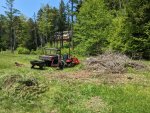NCL4701
Well-known member
Equipment
L4701, T2290, WC68, grapple, BB1572, Farmi W50R, Howes 500, 16kW IMD gen, WG24
Hydraulic feed isn’t a time saver. It’s a control feature that enhances performance and safety by allowing quick reversal of feed, control of feed speed, and hands off feeding. Why are those things important?
Quick directional changes. The obvious is of course if your clothing gets hung on a branch, it’s preferable to reverse feed rather than being chipped to death. Less obvious, but more common in my experience, a branch rotates such that an attached branch or joint jams the feed chute and all it needs is to be rotated a bit to feed right. Reverse, rotate/rearrange, reverse again, continue chipping. Very rare, if ever, need to shut down to clear a feed chute jam after a little practice so long as there’s either enough still outside the chute to safely manipulate it or you have another limb to be chipped to use as a manipulating tool.
Feed speed. The other type jam is discharge chute clogging. Sticky, sappy stuff like Eastern Red Cedar, most any kind of pine; if fed too fast the chips can start to clot like red blood cells and totally block the discharge chute. Slowing the feed rate will alleviate clogging with sticky, sappy stuff. It can also assist with engine bogging if you’re pushing the limits of HP with large branches. Drier wood, hardwood that isn’t so sticky, smaller stuff; up the speed.
Hands off feeding. There are systems other than hydraulic feed that allow hands off feeding. Not aware of anything other than hydraulic that also allows variable feed speed and near instant reverse. In my experience, having your hands, particularly having a good grip, on brush/branches as they engage the chipper knives is less than ideal. The bigger the chipper and bigger/harder the thing being chipped, the worse it is. When a chipper is reducing, for example, a 5” piece of hickory into chips, the knives are hitting it HARD. Even with smaller stuff, if you’re still holding things while they’re engaging the chipper knives, that impact is to a greater or lesser degree translated into your hand/arm. Unless you chipper use is infrequent, short duration, and you are both young and healthy, I would recommend against anything that doesn’t self feed.
Quick directional changes. The obvious is of course if your clothing gets hung on a branch, it’s preferable to reverse feed rather than being chipped to death. Less obvious, but more common in my experience, a branch rotates such that an attached branch or joint jams the feed chute and all it needs is to be rotated a bit to feed right. Reverse, rotate/rearrange, reverse again, continue chipping. Very rare, if ever, need to shut down to clear a feed chute jam after a little practice so long as there’s either enough still outside the chute to safely manipulate it or you have another limb to be chipped to use as a manipulating tool.
Feed speed. The other type jam is discharge chute clogging. Sticky, sappy stuff like Eastern Red Cedar, most any kind of pine; if fed too fast the chips can start to clot like red blood cells and totally block the discharge chute. Slowing the feed rate will alleviate clogging with sticky, sappy stuff. It can also assist with engine bogging if you’re pushing the limits of HP with large branches. Drier wood, hardwood that isn’t so sticky, smaller stuff; up the speed.
Hands off feeding. There are systems other than hydraulic feed that allow hands off feeding. Not aware of anything other than hydraulic that also allows variable feed speed and near instant reverse. In my experience, having your hands, particularly having a good grip, on brush/branches as they engage the chipper knives is less than ideal. The bigger the chipper and bigger/harder the thing being chipped, the worse it is. When a chipper is reducing, for example, a 5” piece of hickory into chips, the knives are hitting it HARD. Even with smaller stuff, if you’re still holding things while they’re engaging the chipper knives, that impact is to a greater or lesser degree translated into your hand/arm. Unless you chipper use is infrequent, short duration, and you are both young and healthy, I would recommend against anything that doesn’t self feed.



